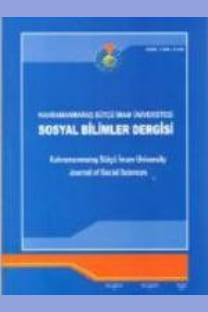Adaptation to Emergency Remote Teaching: Perspectives from Instructors Teaching in English Preparatory Programs
English Language Instructors (ELIs), English Preparatory Programs, COVID 19, Emergency Remote Teaching, English (ERT)
___
- Adedoyin, O. B., & Soykan, E. (2020). Covid-19 pandemic and online learning: The challenges and opportunities. Interactive Learning Environments. Advance online publication. https://doi.org/10.1080/10494820.2020.1813180
- Akbana, Y. E., Rathert, S. & Ağçam, R. (2021). Emergency remote education in foreign and second language teaching. Turkish Journal of Education, 10(2), 97-124. https://doi.org/10.19128/turje.865344
- Artino, A. R. (2010). Online or face-to-face learning? Exploring the personal factors that predict students' choice of instructional format, The Internet and Higher Education, 13(4), 272-276. https://doi.org/10.1016/j.iheduc.2010.07.005
- Bruns, C., Herrmann, T., Böckmann-Barthel, M., Rothkötter, H. J., Bernarding, J., Plaumann, M. (2021). IT support in emergency remote teaching in response to COVID-19. GMS Journal for Medical Education, 38(1).
- Bozkurt, A. & Sharma, R. C. (2020). Emergency remote teaching in a time of global crisis due to CoronaVirus pandemic. Asian Journal of Distance Education, 15(1), i-vi. https://doi.org/10.5281/zenodo.3778083
- Cheung, A. (2021). Synchronous online teaching, a blessing or a curse? Insights from EFL primary students’ interaction during online English lessons, System, 100, 102566 https://doi.org/10.1016/j.system.2021.102566
- Couper, M. P. (2005). Technology trends in survey data collection, Social Science Computer Review 23(4), 486–501.
- Creswell, J. W. (2014). Research design: Qualitative, quantitative, and mixed methods approaches (4th Edition). Thousand Oaks, CA: Sage.
- Dörnyei, Z. (2003). Questionnaires in Second Language Research: Construction, Administration and Processing. New York: Lawrence Erlbaum.
- Erarslan, A. (2021). English language teaching and learning during Covid-19: A global perspective on the first year. Journal of Educational Technology & Online Learning, 4(2), 349-367. http://doi.org/10.31681/jetol.907757
- Felix, U. (2008). The unreasonable effectiveness of CALL: What have we learned in two decades of research? ReCALL, 20(2), 141-161. doi:10.1017/S0958344008000323
- Fishbane, L., & Tomer, A. (2020). As classes move online during COVID-19, what are disconnected students to do? March 20 Brookings Institution. https://www.brookings.edu/blog/the-avenue/2020/03/20/as-classes-move-online-during-covid-19-what-aredisconnected-students-to-do/
- Fryer, L. K & Bovee, H. N. (2016). Supporting students’ motivation for e-learning: teachers matter on and offline. Internet and Higher Education, 30, 21-29. http://dx.doi.org/10.1016/j.iheduc.2016.03.003
- Hakim, B. (2020). Technology integrated online classrooms and the challenges faced by the EFL teachers in Saudi Arabia during the Covid-19 pandemic. International Journal of Applied Linguistics and English Literature, 9(5), 33–39. https://doi.org/10.7575/aiac.ijalel.v.9n.5p.33
- Hodges, C., Moore, S., Lockee, B., Trust, T., & Bond, A. (2020). The difference between emergency remote teaching and online learning. Retrieved from HYPERLINK https://er.educause.edu/articles/2020/3/the-difference-between-emergency-remote-teaching-and-online-learning
- Gacs, A., Goertler, S. & Spasova, S. (2020). Planned online language education versus crisis-prompted online language teaching: Lessons for the future. Foreign Language Annals, 53, 380–392. https://doi.org/10.1111/flan.12460
- Guillen, G., Sawin, T. & Avineri, N. (2020). Zooming out of the Crisis: Language and Human Collaboration. Foreign Language Annals, 53(2), 320-328.
- UNESCO. (2020). Education: From disruption to recovery. Retrieved from https://en.unesco.org/covid19/educationresponse.
- Lin, C. & Warschauer, M. (2015). Online Foreign Language Education: What Are the Proficiency Outcomes? The Modern Language Journal, 99, 394-397.
- Kessler, G. & Hubbard, P. (2017). Language Teacher Education and Technology. In C.A. Chapelle and S. Sauro (Eds.) The Handbook of Technology and Second Language Teaching and Learning. https://doi.org/10.1002/9781118914069.ch19
- Kurtoğlu, P. (2016). Expectations, experiences, and suggestions of newly-hired instructors: A mixed-method, study at a foundation university in Turkey. [Unpublished Master Thesis]. Middle East Technical University.
- Macaro, E., Curle, S., Pun, J., An, J., & Dearden, J. (2018). A systematic review of English medium instruction in higher education. Language Teaching, 51(1), 36-76. doi:10.1017/S0261444817000350
- MacIntyre, P. D., Gregersen, T., & Mercer, S. (2020). Language teachers’ coping strategies during the Covid-19 conversion to online teaching: Correlations with stress, wellbeing and negative emotions. System, 94, 102352. https://doi.org/10.1016/j.system.2020.102352
- Mercer, N. (1994). Neo-Vygotskian theory and classroom education. In B. Steerer & J. Maybin (Eds.), Language, literacy, and learning in educational practice: A reader (92-110). Bristol, PA, USA: Multilingual Matters.
- Moser, K. M., Wei, T. & Brenner, D. (2021). Remote teaching during COVID-19: Implications from a national survey of language educators, System, 97, https://doi.org/10.1016/j.system.2020.102431
- Murphy, L., Eduljee, N. B. & Croteau, K. (2020). College students transition to synchronous virtual classes during the COVID-19 Pandemic in Northeastern United States. Pedagogical Research, 5(4), https://doi.org/10.29333/pr/8485
- Pourtoussi, Z., Ghanizadeh, A., & Mousavi, V. (2018). A Qualitative In-depth Analysis of the Determinants and Outcomes of EFL Teachers’ Motivation and Demotivation. International Journal of Instruction, 11(4), 175-190.
- Sarac, Y. (2020, April 18). Preparing a national roadmap for online higher education. University World News, https://covid19.yok.gov.tr/Documents/AnaSayfa/Preparing-a%20national-roadmap-for-online-higher-education-UWN.pdf
- Shim, T. E., & Lee, S. Y. (2020). College students' experience of emergency remote teaching due to COVID-19. Children and youth services review, 119, 105578. https://doi.org/10.1016/j.childyouth.2020.105578
- Trentin, G. (2007). Pedagogical sustainability of network-based distance education in university teaching. In E. P. Bailey (Ed.) Focus on distance education developments (79–106). Nova Science Publishers Inc.
- Vygotsky, L. S. (1978). Mind in society: The development of higher psychological processes. Harvard University Press.
- White, C. J. (2017). Distance Language Teaching with Technology. In C. A. Chapelle & S. Sauro (Eds.), The Handbook of Technology and Second Language Teaching and Learning (134–148): Hoboken, NJ, USA: Wiley.
- ISSN: 1304-8120
- Yayın Aralığı: 3
- Başlangıç: 2004
- Yayıncı: Kahramanmaraş Sütçü İmam Universitesi
Terörizm İle Mücadele Kapsamında Türkiye, İngiltere Ve İspanya’nın Karşılaştırılması
Canan KATILMIŞ, Işıl ARPACI, Fatma Nur ÖZDEMİR
Kitap İncelemesi (Bürokrasi ve Otorite)
Pazarcık (Kahramanmaraş) İlçesi Arazi Kullanımının Zamansal Değişimi (1990-2018)
Örgütsel Sosyalleşmenin Örgütsel Sessizlik Üzerine Etkisi: Tekstil Sektöründe Bir Alan Araştırması
Mustafa TAŞLIYAN, Bilge GÜLER, Elkhan GURBANLI
Dijital Çağda Tüketicinin Duyularına Hitap Etmek: Çoklu Duyusal Pazarlama Üzerine Bir Araştırma
Zümrüt Hatice ŞEKKELİ, İsmail BAKAN, Mehtap BAKAN
Geleneksel Kazak Toplumunda Biy Mahkemeleri (XVIII-XIX. Yüzyıllar)
Mersin’ in Kuzeyindeki Sayfiye Yerleşmeleri ve Arazi Kullanımındaki Değişim
Mine KÜÇÜKLER, İbrahim YILDIRIM
CHP Genel Sekreterlerinin Parti Siyaseti Üzerindeki Etkileri: Kasım Gülek Ve Bülent Ecevit
